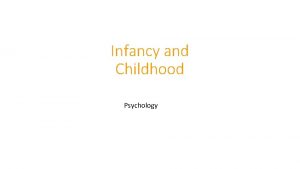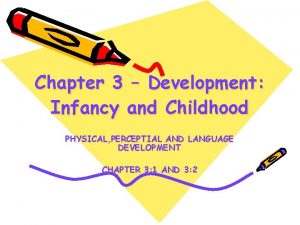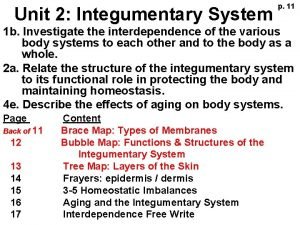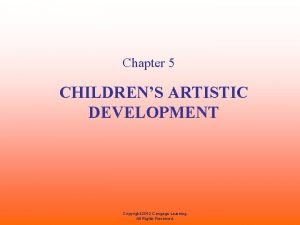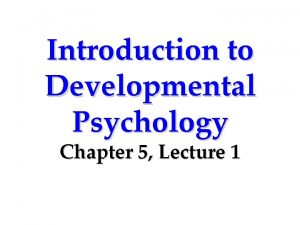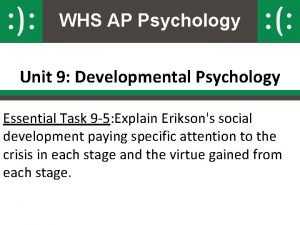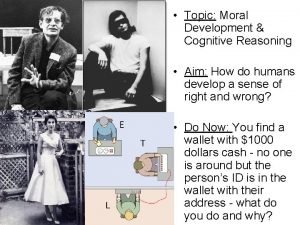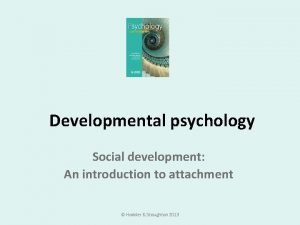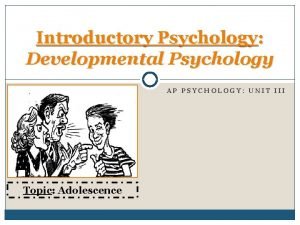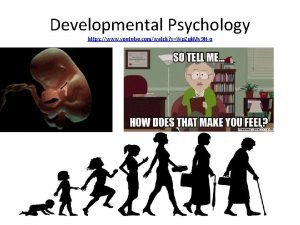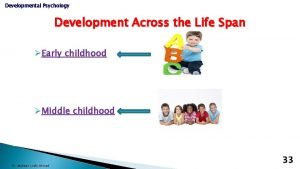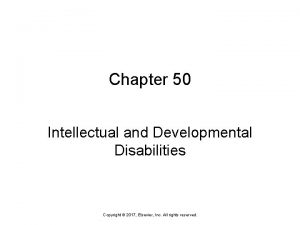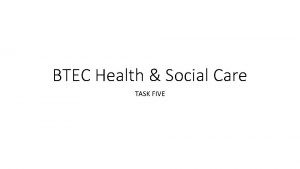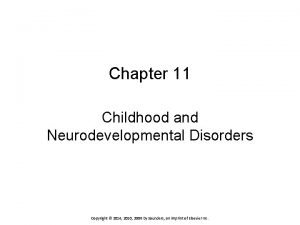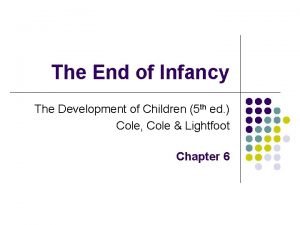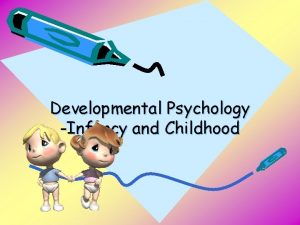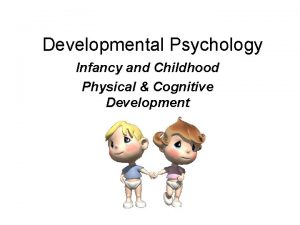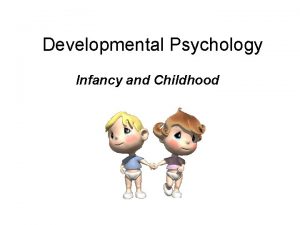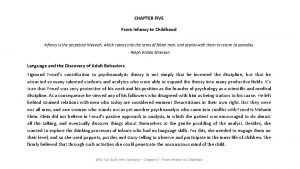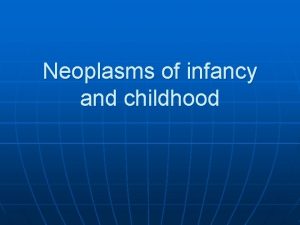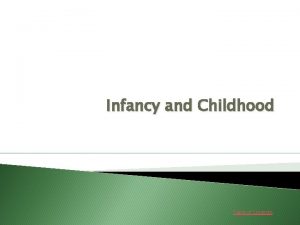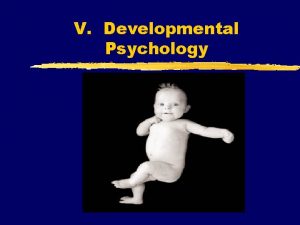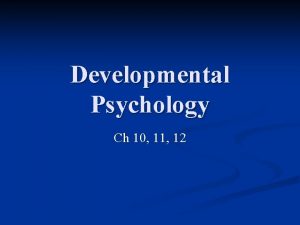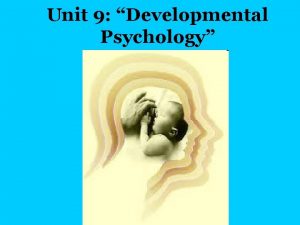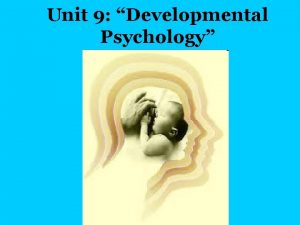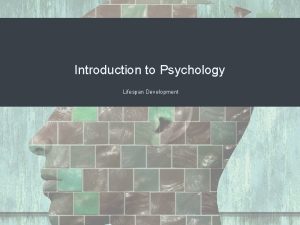Developmental Psychology Infancy and Childhood Chapter 10 Infancy
































- Slides: 32

Developmental Psychology Infancy and Childhood Chapter 10

�Infancy v. Birth – two years �Childhood v. Two years to adolescenc e

Physical Development � Pregnancy = remarkable growth : microscopic → 20 inches long with all organs and limbs and body parts in tact…including the miraculous brain we’ve been talking about. � Reflexes are automatic.

Physical Development � Infancy – › 1 st year: triple birth weight and grow about 10 inches › 2 nd year: gain 4 -7 lbs and grow 4 -6 inches � Childhood – › After 2 years, children gain about 2 -3 inches in height and 4 -6 lbs per year until they reach adolescence.

Physical Development � Motor Development › Gross= rolling over, crawling, walking › Fine = hand eye coordination, grabbing things, holding things, throwing › Improves with age � Perceptual Development › Vision changes from complex images to a preference for face. › Suggests a theory for nature and nurture › The sense of sound is almost immediate. › The sense of smell is almost immediate as well.

Social Development � Attachment – emotional ties that form between people � By 4 months, infants prefer to be with someone. They cry when separated from mothers. � Stranger anxiety � Separation anxiety

Development of Attachment � Contact comfort – babies want to feel the soft contact of their mother’s � Attachment enables babies to feel secure and explore. � Harry F. Harlow’s Study

Caregivers are reliable and protective � Children become more successful and comfortable in their environment � Have healthier relationships in the future with partners, teachers, and peers. When caregivers are unresponsive or unreliable � Children do not mind being left alone, but they do not trust the caregiver. � They often cry when the caregiver is responsive as if they are angry. � Effects future relationships in a negative way. Secure � Insecure Effects of Attachment �

� Warm � � � Cold Parenting Styles � � � Supportive Protective Affectionate Caring Children are well adjusted Children develop a conscience Indifferent Careless Detached Negligent Children are interested in escaping punishment Lack of conscience

� Strict � � � Permissive Parenting Styles � � � Demanding Controlling Dictatorial Antagonistic Want order Consistent and firm enforcement of rules can foster achievement and self-control as long as it is paired with love and support. Lenient Democratic Inconsistent Overindulgent Want freedom to express No time to monitor children

Self-Esteem › Secure attachment encourages self-esteem › Parenting style also effects self-esteem › Which parenting styles encourage self-esteem? � Age and self-esteem › In elementary school, children tend to have low self-esteem because they think other people see them the way they see themselves.

Cognitive Development Jean Piaget Style Sensorimotor Stage › Age – 0 -2 › Object permanence, sensation and perception with motor activity � Preoperational Stage › Age – 2 -7 › One-dimensional thinking, egocentrism, artificialism, animistic � Concrete-Operational Stage › Age – 7 -12 › Signs of adult thinking (not abstract), reduced egocentrism � Formal-Operational Stage › Age – 12+ › Abstract thought, hypothetical situations, strategy, plan ahead �

Kind of Thinking Sample Questions Typical Answers Egocentric Why does the sun shine? To keep me warm Why is the grass green? Because that’s my favorite color What are TV sets for? To watch my favorite cartoons Why do stars twinkle? Because they’re happy Why do trees have leaves? To keep them warm Where do boats go at night? They go to sleep, like me. Why is the sky blue? Somebody painted it Where do mountains come from? A giant built them What is the wind? A person blowing Artificialistic Animistic

Moral Development Lawrence Kohlberg Style Preconventional Level › 1. Avoiding Punishment › 2. Satisfying Needs � Conventional Level › 3. Winning approval › 4. Law and order �High regard for authority � Postconventional Level › 5. Social Order �Personal values, accepted laws › 6. Universal Ethics �Morality of individual conscience �

Abuse and Neglect � Physical, sexual, emotional, and psychological abuse is widespread › Underreported › Unable, unwilling, or afraid � Neglect › Failure to provide adequate food, shelter, clothing, schooling and emotional support

Why do parents abuse and neglect their children? � Stress � History of abuse themselves � Acceptance of violence as a coping method � Lack of attachment to the child � Substance abuse � Alcoholism to cope › Leads to abuse › Genetic

Affects of Child Abuse � Higher risk of developing psychological issues � Less likely to be close to their peers � More likely to continue the pattern into adulthood � Adopt parents attitudes of discipline

How to children deal with and overcome abuse and neglect? � If helped, children can learn to deal with issues � If help is sought from a non-abusive adult, such as a teacher, coach, or guidance counselor, patterns of abuse can be changed

DEVELOPMENTAL PSYCHOLOGY Adolescence Chapter 11

STAGES OF ADOLESCENT DEVELOPMENT Early � 11 Adolescence through 14 Middle � 15 Late � 18 Adolescence through 18 Adolescence though 21

PHYSICAL DEVELOPMENT Growth spurt � Girls start the spurt at age 10 or 11. � Boys start the spurt at age 12 or 13. � Most adolescents grow about 8 -12 inches during this 23 year process. Awkwardness � Parts of the body grow and change at different rates. � EX. Hands and feet may look too big.

SEXUAL CHANGES Changes in Males Changes in Femals Testes increase output of testosterone Ovaries secrete more estrogen. Sexual organs grow. Growth of breast tissue. Voice deepens. Growth of supportive tissue in the hips and buttocks. Hair on face and chest; growth of pubic and underarm hair. Pelvic region widens. Broader shoulders, thicker body. Hips become rounder. More muscles, Growth of pubic and underarm hair Larger heart and lungs Menstruation

SOCIAL DEVELOPMENT Relationships with Parents � Quest for independence Relationships with Peers � Value loyalty � Choose friends with similarities � Cliques � Peer pressure

WHY DO PEOPLE DATE? Enjoy spending time with somebody they like Helps them learn how to relate positively to other people Helps prepare for more serious courtships late in life Dating relationships start off has casual and shortlived and grow into stable and committed relationships with maturity.

IDENTITY FORMATION According to Erikson, the main task of an adolescent is to form an identity. Experiments with different beliefs, roles, values, and relationships Identity crisis: Who am I? Identity moratorium � Searching for identity, exploring alternatives Identity foreclosure Conforming, accepting childhood identity and values, identifying with others � Making commitments and plans without self examination � Identity diffusion � Making no commitment, no soul searching Identity achievement � Exploring options, committing to direction in life and occupation, finding own identity

CHALLENGES OF ADOLESCENCE Problems at home � Family Problems � Conflicts with Parents � Getting a good job � Providing for the family Problems at School � Grades, graduation, getting into college, participating in extracurricular activities, overwhelming work load Problems with Peers � Boyfriends/Girlfriends � Fitting in with peer groups � Social acceptance

EATING DISORDERS Effects more girls than boys Anorexia Nervosa � Self-starvation Bulimia Nervosa � Binge and body distortion issues and purge Why? � Return to the way they were before puberty � Avoid growing up � Cope with loneliness � Participation in sports and extracurriculars

SUBSTANCE ABUSE Why? � Curiosity, peer pressure, parental use, rebelliousness, escape from boredom or pressure, search for excitement and pleasure What are they using? � 35% of teenagers smoke � 27% use Marijuana � Almost all high school and college students use or have tried alcohol � Athletes and cocaine Marijuana � Contains more tar than cigarettes, elevates heart rate and blood pressure, affects retention of information

ALCOHOL ABUSE Use to deal with stress, peer pressure, or parental use Reduce anxiety and tension Can lead to aggressive behavior, poor grades, degrading of social skills, dependence, and car accidents Persons can easily become addicted to alcohol which can easily affect their personality and relationships with others Prefrontal Cortex development

SEXUALITY Parents adults say “No” vs. body saying “Yes!” Many adolescents are not sexually active Dating earlier in life means you are more likely to have sexual relationships in high school ½ of all adolescent girls who get pregnant end up dropping out of school and on welfare

CRIME Not connected to socioeconomic status Factors that contribute � Low self-esteem � Alienation and estrangment � Lack of affection, discipline, and punishment � Poor grades � Pressure from peers � Parents who have a criminal history

GETTING HELP AND PREVENTION Teens that fear the onset of a particular problem (aka alcohol abuse, substance abuse, crime, eating disorders, etc. ) are more likely to stop their problem if they seek help from a trusted adult Easier to fix a problem before it starts than after a person is addicted Students who talk about their problems for prevention purposes are more likely to get good grades, graduate from high school, go to college, and get a steady job than those who think they either don’t have a problem or don’t get help
 Psychology chapter 10 infancy and childhood
Psychology chapter 10 infancy and childhood Chapter 10 infancy and childhood review worksheet answers
Chapter 10 infancy and childhood review worksheet answers Chapter 10 infancy and childhood
Chapter 10 infancy and childhood Early middle childhood
Early middle childhood Infancy and childhood psychology
Infancy and childhood psychology Social development in infancy and childhood
Social development in infancy and childhood Module 47 infancy and childhood cognitive development
Module 47 infancy and childhood cognitive development Internally programmed growth of a child
Internally programmed growth of a child Lesson quiz 3-2 infancy and childhood
Lesson quiz 3-2 infancy and childhood Rovee-collier
Rovee-collier Module 47 infancy and childhood cognitive development
Module 47 infancy and childhood cognitive development Infancy childhood adolescence adulthood old age
Infancy childhood adolescence adulthood old age Kellogg's artistic developmental stages
Kellogg's artistic developmental stages Chapter 5 developmental psychology
Chapter 5 developmental psychology Ap psychology unit 9
Ap psychology unit 9 Lawrence kohlberg developmental psychology
Lawrence kohlberg developmental psychology Research methods in developmental psychology
Research methods in developmental psychology History of developmental ideas in psychology
History of developmental ideas in psychology Attachment developmental psychology
Attachment developmental psychology Developmental psychology
Developmental psychology Devonte is a graduate student in developmental psychology
Devonte is a graduate student in developmental psychology Unit 3 developmental psychology
Unit 3 developmental psychology Ucf psychology department
Ucf psychology department Sublimation psychology
Sublimation psychology Middle childhood psychology
Middle childhood psychology Chapter 5 cognitive development in infancy and toddlerhood
Chapter 5 cognitive development in infancy and toddlerhood Chapter 50 intellectual and developmental disabilities
Chapter 50 intellectual and developmental disabilities Social trap example
Social trap example 6 life stages
6 life stages What is intellectual in health and social care
What is intellectual in health and social care Chapter 11 developmental theories
Chapter 11 developmental theories Chapter 11 childhood and neurodevelopmental disorders
Chapter 11 childhood and neurodevelopmental disorders Infancy period
Infancy period




